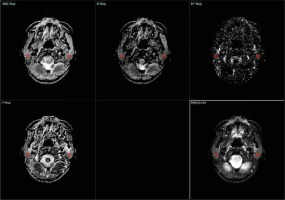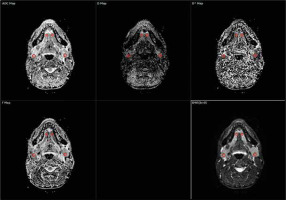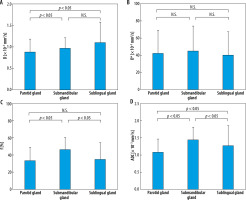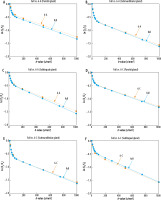Introduction
Intravoxel incoherent motion (IVIM) involves the diffusion of water molecules and perfusion [1,2]. Diffusion-weighted imaging (DWI) is used to evaluate IVIM. However, the diffusion of water molecules alone can be evaluated through DWI using high b-values to exclude perfusion. Le Bihan proposed the use of IVIM-DWI, which could assess the diffusion of water molecules and perfusion separately [2].
The apparent diffusion coefficient (ADC) is generally used as the quantitative parameter in DWI. In IVIM-DWI, the diffusion of water molecules and perfusion are evaluated using the following parameters: perfusion fraction (f [%]), diffusion coefficient (D [mm2/s]), and pseudo-diffusion coefficient (D × [mm2/s]). The IVIM parameters were calculated using the following equation:
where Sb is the signal intensity at a b-value greater than 0 s/mm2 and S0 is the signal intensity at a b-value of 0 s/mm2. Equation (1) shows a bi-exponential function, and a bi-exponential curve fitting is performed on the graph of Equation (1). Thus, multiple b-values are required to obtain IVIM parameters. IVIM-DWI using a large number of b-values can accurately estimate IVIM parameters. However, this method is disadvantageous because it has a long imaging time [3]. The b-values in IVIM-DWI in individuals with kidney [4], prostate [5], and breast cancers [6] have been evaluated. Previous studies have reported that the required number of b-values in IVIM-DWI of the abdomen is more than 10 [3], and more than 2 b-values between 0 and 50 s/mm2 are required in IVIM-DWI of the liver [7]. Furthermore, 4 optimised b-values can be used for the assessment of IVIM parameters in liver lesions [8].
Some studies have reported the utility of IVIM-DWI in patients with salivary gland tumours, pharyngeal cancer, laryngeal cancer, and lymph node metastasis in the head and neck [9-18]. However, there has been no report on the optimal number and combination of b-values in IVIM-DWI of major salivary glands, and the optimum settings of b-values in that must be investigated to maintain the quality in the assessment of each parameter and shorten the imaging time.
Thus, the current study aimed to examine the optimal number and combination of b-values in IVIM-DWI of the major salivary glands.
Material and methods
Participants
This study was approved by our institutional review board, and written informed consent was obtained from all participants. Ten healthy volunteers (4 men and 6 women, with an average age of 21.7 [range: 21-24] years) were enrolled in this study.
Magnetic resonance imaging
All healthy volunteers underwent MRI using a 1.5-T machine (Echelon Vega, Hitachi, Ltd., Tokyo, Japan) with a 16-channel head coil. Magnetic resonance imaging (MRI) was performed using multi-shot spin echo-echo planar imaging (EPI) with 2 shots and 13 b-values (low b-values: 0, 10, 20, 30, 40, 50, 75, and 100 s/mm2; high b-values: 200, 300, 500, 750, and 1000 s/mm2). Low and high b-values were distinguished by a b-value of 200 s/mm2 because the influence of perfusion was almost excluded using b-values larger than 200 s/mm2. The following parameters were used: repetition time/echo time, 3300/62.4 ms; field of view, 230 × 230 mm2; matrix size, 136 × 192; thickness/gap, 5.0/0.5 mm; number of signal averages, 2; sensitivity encoding factor, 2; fat saturation, chemical shift selective; and bandwidth, 250 kHz. Intervals of motion probing gradient (MPG) pulses (Δ) were 30.724 ms, and the duration of each MPG pulse (δ) was 21.056 ms. The scanning time was 12 min and 21 s. Before every acquisition of IVIM-DWI, calibration scans to predict and correct the eddy current caused by MPG pulses were performed.
Calculation of the IVIM parameters and ADC
The influence of D* can be neglected when b-values larger than 200 s/mm2 were used. Thus, Equation (1) on this condition can be simplified as follows:
where Sb1 and Sb2 are signal intensities at different b-values, which are equal to or greater than 200 s/mm2.
We first obtained D with the least-squares method using Equation (2). Then, D* and f were obtained with the Nelder-Mead simplex method using Equation (1) [19] because low perfusion fraction, limited sampling, or low precision were challenging in a simultaneous nonlinear fit using Equation (1) [20].
We used a workstation (Volume analyser SYNAPSE VINCENT, FUJIFILM Corporation, Tokyo, Japan) to calculate each parameter. The regions of interest (ROIs) in the bilateral parotid, submandibular, and sublingual glands were set manually in DWI at a b-value of 0 s/mm2 by a radiologic technologist (Figures 1 and 2). The sizes of the ROIs were 39.5, 39.5, and 23.4 mm2, respectively. A single ROI was set for each salivary gland. Then, they were copied automatically in an ADC, D, D*, and f maps. The average signals in each ROI were calculated. The ROIs were set to avoid large vessels or salivary gland ducts at the maximum diameter level of the salivary gland by referring to DWI at a b-value of 0 s/mm2 and an ADC map. ADC was calculated using the following equation:
Figure 1
Regions of interest (ROIs) in an apparent diffusion coefficient (ADC) map, D map, D* map, f map, and diffusion-weighted imaging (DWI) at a b-value of 0 s/mm2 in the bilateral parotid glands. A radiologic technologist manually set the ROIs in the bilateral parotid glands in DWI at a b-value of 0 s/mm2. The size of the ROI is 39.5 mm2. The ROIs were copied automatically on an ADC map, D map, D* map, and f map

Figure 2
Regions of interest (ROIs) in an apparent diffusion coefficient map, D map, D* map, f map, and diffusion-weighted imaging (DWI) at a b-value of 0 s/mm2 in the bilateral submandibular and sublingual glands. The ROIs in the bilateral submandibular and sublingual glands were set similarly to those in the bilateral parotid glands. The sizes of the ROIs are 39.5 and 23.4 mm2, respectively

where Sb1 and Sb2 are signal intensities at different b-values (b1 and b2). We obtained the ADC with the least-squares method using Equation (3).
Quantitative analysis
First, the parameters were calculated through IVIM-DWI using 13 b-values (the full combination) and were considered the standard values. Second, each parameter was calculated through IVIM-DWI using 10 b-values (10-A to 10-D combinations) selected from the full combination, and each parameter was compared with the standard values. Table 1 shows the number and combination of b-values. Thereafter, combinations of 8 b-values were used by referring to the combinations of 10 b-values. Each parameter was calculated through IVIM-DWI using combinations of 8 b-values and was compared with the standard values. Using a similar method, the combinations of 6 and 5 b-values were used, and each parameter was calculated and compared with the standard values. A b-value of 0 s/mm2 was included in all combinations because Equation (1) included S0, which was the signal intensity at a b-value of 0 s/mm2.
Table 1
The number and combination of b-values
For the parameters in the full combination and the combinations of b-values that did not significantly differ from the standard values, we calculated the mean values of the signal intensity and standard deviations (SDs) of these parameters in the major salivary glands. When we calculated the mean values of the signal intensity and SDs, the ROIs were set manually on DWI at each b-value by a radiologic technologist, similarly to the evaluation of IVIM parameters and ADC. Additionally, the signal-to-noise ratio (SNR) in the major salivary glands of each b-value was calculated using the following equation:
where S is the signal intensity in each major salivary gland and SD is the standard deviation of the signal intensity in each major salivary gland. The signal intensity shows the mean value in the ROIs of the bilateral major salivary glands.
The bi-exponential signal decay curves in some combinations of b-values were obtained in the major salivary glands. These curves were obtained by substituting Equation (1) for b-values and mean values of IVIM parameters in the major salivary glands.
Statistical analysis
The Wilcoxon signed-rank test was used to determine whether there were any differences between the standard values and parameters assessed through IVIM-DWI using each combination (p < 0.05). JMP® 15 software (SAS Institute Inc., Cary, NC, USA) was used for the analysis. Moreover, we applied Bonferroni correction for multiple comparisons and set the corrected significance level to less than 0.05/4 = 0.0125.
The coefficient of variation (CV) was used to evaluate the reproducibility of ln (Sb/S0) for each b-value in 10 volunteers. Moreover, it was used to evaluate the reproducibility of each parameter in the major salivary glands of 10 volunteers and was calculated using the following equation:
The CV was calculated using the mean value and SD for each parameter of 10 volunteers.
The Steel-Dwass test was used to determine whether there were any differences in each parameter in the major salivary glands (p < 0.05). JMP® 13 software (SAS Institute Inc., Cary, NC, USA) was used for the analysis.
Results
The number and combination of b-values
Table 1 shows the number and combination of b-values. The 8-A and 8-B combinations were obtained using the 10-A combination because there were no significant differences between the standard values and parameters derived using IVIM-DWI with the 10-A combination. The 8-C and 8-D combinations were achieved using the 10-B combination, 6-A and 6-B combinations using the 8-B combination, 6-C and 6-D combinations using the 8-D combination, and the 5-A combination was obtained using the 6-A and 6-C combinations because there were no significant differences between the standard values and parameters derived using IVIM-DWI with the 10-B, 8-B, 8-D, and 6-A, 6-C combinations, respectively.
Quantitative analysis
Tables 2, 3, 4, and 5 demonstrate the mean values ± SD of the IVIM parameters and ADC in the bilateral major salivary glands for each combination of b-values. There were statistically significant differences between the standard values and parameters derived using IVIM-DWI with the 10-C, 10-D, 8-A, 8-C, 6-B, and 5-A combinations (p < 0.0125).
Table 2
The mean values and SD of the D values [× 10-3 mm2/s] in the bilateral major salivary glands of each combination
Table 3
The mean values and SD of the D* values [× 10-3 mm2/s] in the bilateral major salivary glands of each combination
Table 4
The mean values and SD of the f values [%] in the bilateral major salivary glands of each combination
Table 5
The mean values and SD of the ADC values [× 10-3 mm2/s] in the bilateral major salivary glands of each combination
Table 6 shows the CV of ln (Sb/S0) for each b-value in the major salivary glands. The CV of ln (Sb/S0) at a b-value of 10 s/mm2 was the lowest among the low b-values, and that for a b-value of 300 s/mm2 was the highest among the high b-values in all the major salivary glands. Figure 3 presents the mean values and SD of the IVIM parameters and ADC in the major salivary glands, and Table 7 depicts their CV. There were statistically significant differences in IVIM parameters in some pairs of major salivary glands (p < 0.05). The f values for the submandibular gland in Figure 3 were significantly higher than the those for the other 2 glands. The CV in D, D*, f, and ADC values were 25.0-43.1%, 64.0-67.0%, 30.0-56.0%, and 25.2-46.0%, respectively, in the major salivary glands. Table 8 shows the SNR in the major salivary glands for each b-value. The average SNR of each b-value in the major salivary glands was 6.04-10.2.
Table 6
The CV of ln (Sb/S0) for each b-value
Table 7
The CV of IVIM parameters and ADC in the bilateral major salivary glands
| Parotid gland | Submandibular gland | Sublingual gland | |
|---|---|---|---|
| The CV [%] of D values | 33.4 | 25.0 | 43.1 |
| The CV [%] of D* values | 64.0 | 64.9 | 67.0 |
| The CV [%] of f values | 45.9 | 30.0 | 56.0 |
| The CV [%] of ADC values | 36.0 | 25.2 | 46.0 |
Table 8
The SNR in the major salivary glands for each b-value
Figure 3
Mean values and standard deviation (SD) of the intravoxel incoherent motion (IVIM) parameters and apparent diffusion coefficient (ADC) in the major salivary glands. There were statistically significant differences in IVIM parameters and ADC in some pairs of the major salivary glands (p < 0.05)

The signal decay curves
Figure 4 shows the bi-exponential signal decay curves obtained from the full combination and the 6-A and 6-C combinations in the major salivary glands. There were few differences between the bi-exponential signal decay curves obtained from the full combination and the 6-A and 6-C combinations.
Discussion
Our study showed that the number of b-values could be reduced to a minimum of 6 in IVIM-DWI of the major salivary glands. Moreover, they should include 3 low and 3 high b-values. This result was based on the fact that there were no significant differences between the standard values and parameters derived using IVIM-DWI with either the 6-A or 6-C combination. Conversely, there were statistically significant differences between the standard values and parameters derived using IVIM-DWI with the 5-A combination, which included 2 low b-values, and the 10-C and 10-D combinations, which included 2 high b-values. Based on the combinations of b-values with a statistically significant difference in the parameters compared with the standard values, we believe that IVIM-DWI using 5 or fewer b-value combinations should have demonstrated a significant difference from the standard values, and we believe that it is possible that IVIM-DWI of the major salivary glands could be performed using 3 low and 3 high b-values at the lowest. Additionally, Figure 4 shows few differences between the bi-exponential signal decay curves obtained from the full combination and the 6-A and 6-C combinations in the major salivary glands. Moreover, the imaging time of IVIM-DWI with 6 b-values such as the 6-A or 6-C combination was about a half of that with 13 b-values (full); therefore, less motion artefact of IVIM-DWI with 6 b-values could be expected to occur compared with that with 13 b-values (full). This needs to be validated in future studies [8]. Therefore, we believe that it is possible that IVIM-DWI of the major salivary glands could be performed using 3 low and 3 high b-values.
The CV of ln (Sb/S0) at a b-value of 10 s/mm2 was the lowest among the low b-values in all the major salivary glands, and we speculated that there was less difference in the bi-exponential curve fitting between the combinations with a b-value of 10 s/mm2 and full. Thus, there were no significant differences between the standard values and parameters derived using IVIM-DWI with 3 low b-values, which included a b-value of 10 s/mm2. The CV of ln (Sb/S0) at a b-value of 300 s/mm2 was the highest among the high b-values in all the major salivary glands, and we speculated that there were large differences in the bi-exponential curve fitting between the combinations with a b-value of 300 s/mm2 and full. Therefore, there were statistically significant differences between the standard values and parameters derived using IVIM-DWI with 3 high b-values, which included a b-value of 300 s/mm2. Moreover, the CV of ln (Sb/S0) in all b-values was high (27.2-234%); therefore, we speculated that there could be differences in the bi-exponential curve fitting between the combinations of 10-C with 2 high b-values, 5-A with 2 low b-values, and full.
Figure 3 shows that statistically significant differences were observed in the parameters in some pairs of the major salivary glands. The parotid sublingual, and submandibular glands are serous, mucus, and mixed types of serous and mucus glands, respectively. Thus, the histological difference might have caused statistically significant differences in the parameters of the major salivary glands.
The f values for the submandibular gland in Figure 3 were significantly higher than those for the other 2 glands, and the CV of D, D*, f, and ADC values in the major salivary glands were high in Table 7 (25.0-43.1%, 64.0-67.0%, 30.0-56.0%, and 25.2-46.0%, respectively). Additionally, the average SNR of each b-value was 6.04-10.2 in our study, which was almost similar to the critical SNR reported in a previous study on b-values of IVIM-DWI optimized using Monte-Carlo simulations [3]. Moreover, Verhappen et al. or Mikayama et al. reported that the susceptibility artefacts of EPI-DWI derived using magnetic inhomogeneity cause image distortion in the head and neck, and they may inhibit obtaining accurate measurements of IVIM parameters and ADC [18,21]. Furthermore, the submandibular glands or the organs in proximity to the airway or jaw might be more sensitive to motion artefacts for respirating or swallowing [22]. Slightly low SNR, susceptibility artefacts, and motion artefacts might have affected the measurement of each parameter in this study. Thus, we speculated that the f values for the submandibular gland were significantly higher than those for the other 2 glands, and the CV of D, D*, f, and ADC values in the major salivary glands were high.
This study has several limitations. First, our study only included young and normal volunteers, and the presence of salivary gland tumours was not investigated. Second, our study population was relatively small. Thus, future studies with several volunteers and patients, including both young and elderly individuals, should be conducted. Third, EPI-DWI was used in the IVIM-DWI of this study. We suspect that distorted images due to magnetic inhomogeneity around the major salivary glands in EPI-DWI affected the IVIM parameters and ADC in this study. Hence, future studies using an imaging method such as turbo spin echo (TSE)-DWI, which can cause few susceptibility artefacts or minimal distortion in IVIM-DWI, can improve the evaluation of each parameter of the major salivary glands.



